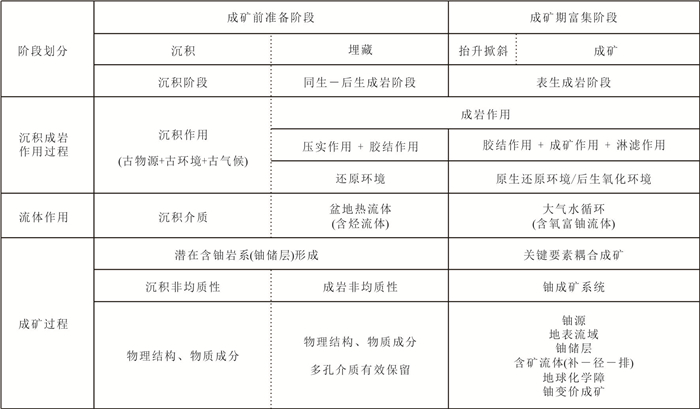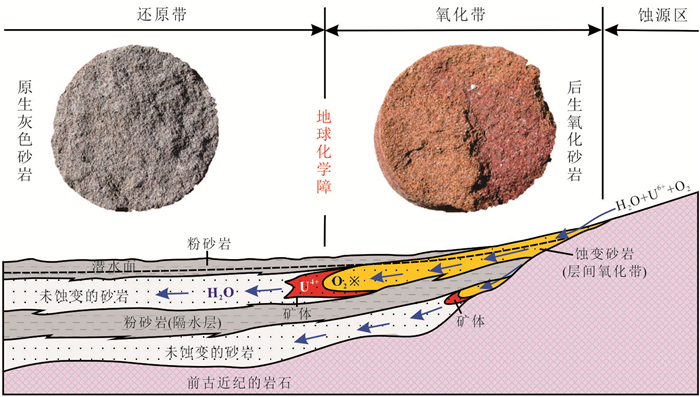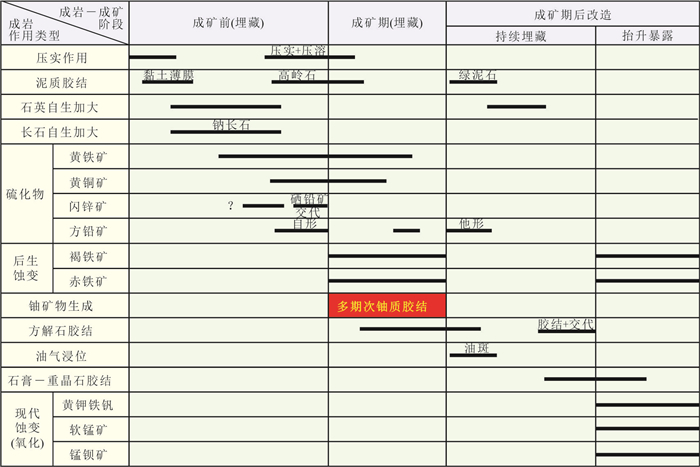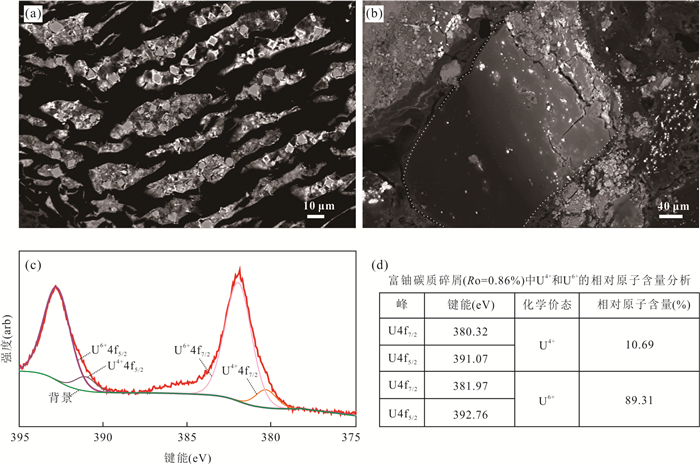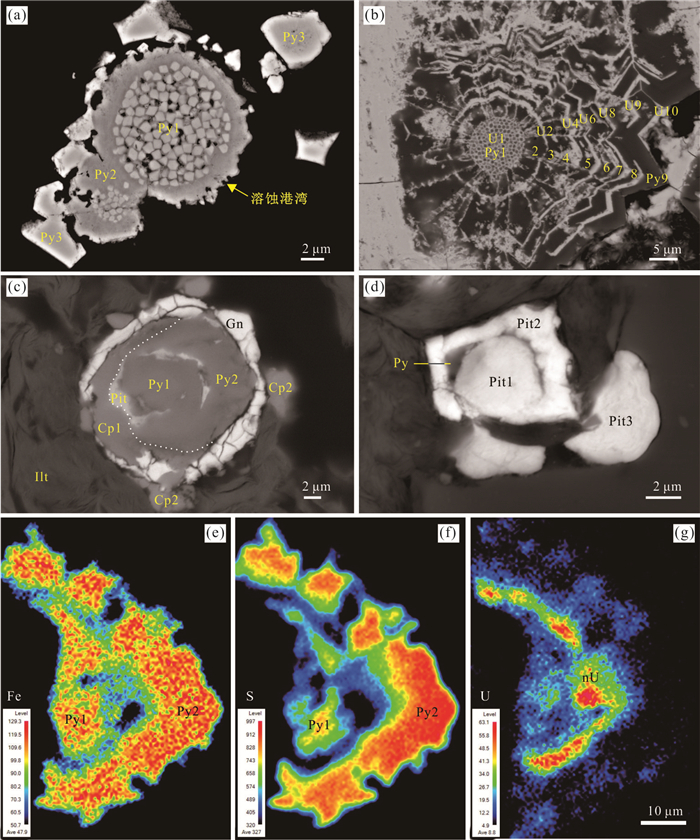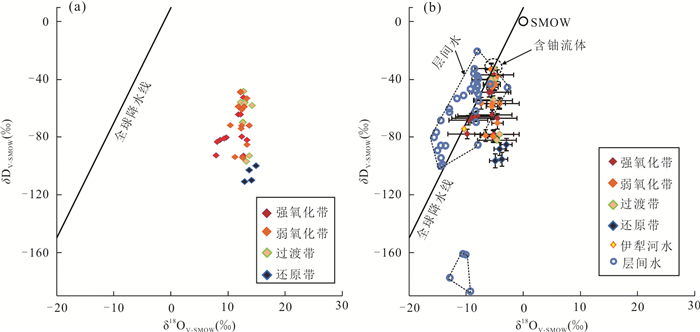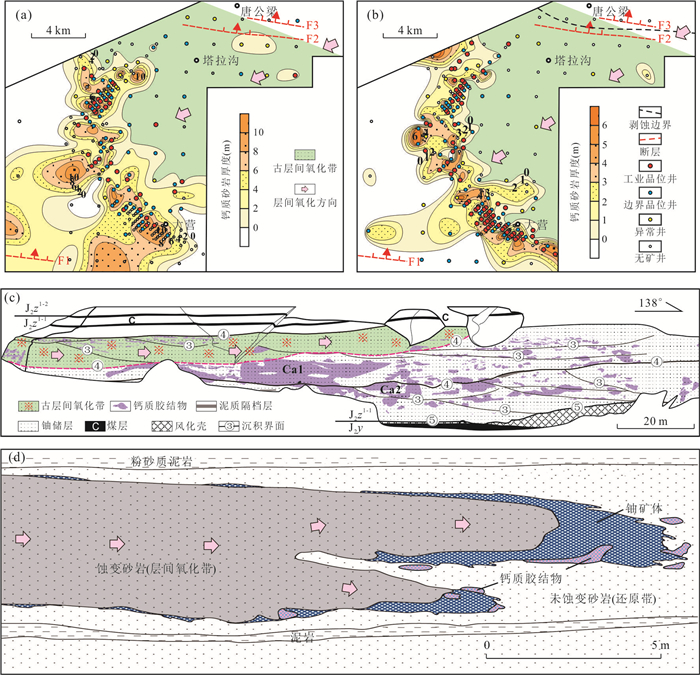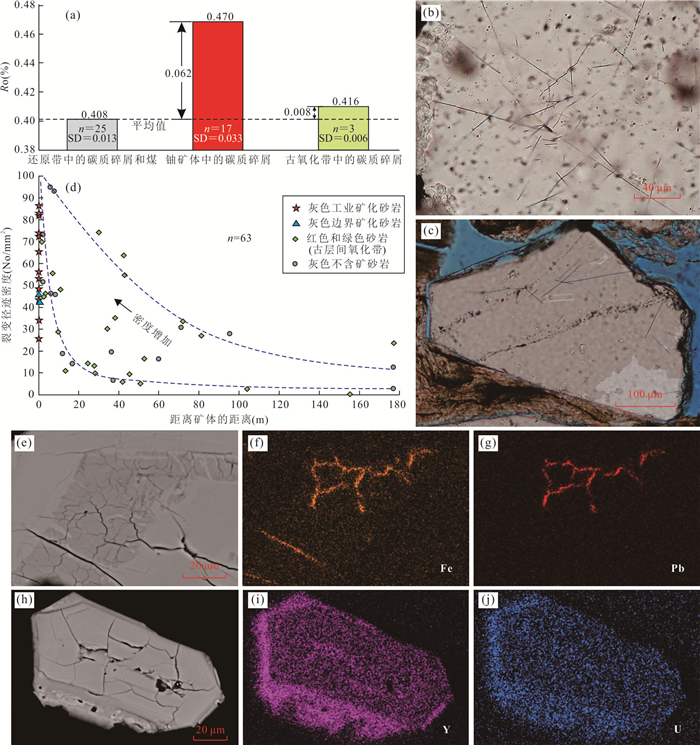Sedimentation, Diagenesis and Uranium Mineralization: Innovative Discoveries and Cognitive Challenges in Study of Sandstone-Type Uranium Deposits in China
-
摘要: 21世纪,中国在砂岩型铀矿勘查领域获得了前所未有的辉煌成就.砂岩型铀矿产出于沉积盆地,铀矿的形成必须经历由沉积埋藏到抬升成矿两个重要的演化阶段.其中,在抬升成矿阶段,大气降水和氧化-还原作用的参与和约束是最显著的成矿特征.显然,这是一种典型的表生成岩作用的产物,是铀储层复杂成岩序列中的重要一环,隶属于“外生成矿”的范畴.虽然,砂岩型铀矿的成矿作用遵循氧化还原与铀变价的普遍机理,但是特殊的沉积背景却导致了铀成矿作用的多样性和地区的专属性.一些由沉积作用、沉积环境和古气候造就的关键控矿要素,能够从“基因”上直接影响表生成岩阶段的铀成矿作用,由沉积、成岩到铀成矿是一个具有成因联系的地质过程,而盆山耦合机制始终是其最根本的原始驱动力.随着对铀成矿作用细节行为研究的深入,一些创新发现不断地冲击着以往固有的认识,诸如碳质碎屑与铀成矿的相互作用、黄铁矿复杂而有序的演化习性、碳酸盐胶结物与铀成矿的共生叠置、敏感矿物的流体示踪、铀储层非均质性制约下的铀成矿机理、双重还原介质制矿模型、铀成矿的复合地球化学障等.还有一些研究对传统地质学理论提出了认知挑战,诸如,铀储层开放成岩环境中碳质碎屑的“碳化作用机理”、黄铁矿溶蚀或者生长界面上的铀沉淀化学动力机制、干旱沉积背景的铀成矿机理等.同时,铀成矿机理和普遍规律的研究,也为砂岩型铀矿的衰变地质效应研究和盆地铀资源的系统探索奠定了良好的地质基础.相信,针对沉积盆地整装的系统的成矿机理与成因联系研究,必将释放巨大的盆地铀资源潜力和矿床产能,在进一步丰富铀成矿理论的同时助力实现“双碳目标”.Abstract: In the 21th century, China has made brilliant achievements in the exploration of sandstone-type uranium deposits. Sandstone-type uranium deposits are located in sedimentary basins. The formation of uranium deposits must go through two important evolutionary stages from sedimentary burial stage to uplift metallogenic stage. The participation and restriction of atmospheric precipitation and oxidation-reduction are the most significant metallogenic characteristics in the uplift metallogenic stage. Obviously, this is the product of a typical supergene diagenesis, an important link in the complex diagenetic sequence of uranium reservoirs, and belongs to the category of "exogenetic mineralization". Although the mineralization of sandstone-type uranium deposit follows the general mechanism of oxidation-reduction and uranium valence change, the special sedimentary background leads to the diversity and regional specificity of uranium mineralization. Some key ore controlling elements created by sedimentation, sedimentary environment and paleoclimate can directly affect uranium mineralization in epigenetic rock stage from "gene". From sedimentation, diagenesis to uranium mineralization is a geological process with genetic connection, and the basin-mountain coupling mechanism is always the most fundamental original driving force. With the in-depth study of the detailed behavior of uranium mineralization, some innovative discoveries continue to impact the previous inherent understanding, such as the interaction between carbonaceous debris and uranium mineralization, the complex and orderly evolution habit of pyrite, the symbiosis and superposition of carbonate cement and uranium mineralization, the fluid tracing of sensitive minerals, the uranium mineralization mechanism restricted by the heterogeneity of uranium reservoir, the ore making model of double reducing medium, and compound geochemical barrier of uranium mineralization, etc. Other studies have posed cognitive challenges to traditional geological theories, such as the "carbonization mechanism" of carbonaceous debris in the open diagenetic environment of uranium reservoir, the chemical dynamic mechanism of uranium precipitation on the dissolution or growth interfaces of pyrite, the uranium metallogenic mechanism in arid sedimentary background, etc. At the same time, the study of uranium metallogenic mechanism and general law has also laid a good geological foundation for the study of geological effects of sandstone-type uranium deposit decay and the systematic exploration of basin uranium resources. It is believed that the systematic study on the metallogenic mechanism and genetic relationship of the whole sedimentary basin will release the huge basin uranium resource potential and deposit productivity, and help to achieve the "double carbon goal" while further enriching the uranium metallogenic theory.
-
图 1 十红滩铀矿床不同阶段地质环境的演变对比(据焦养泉等,2004修改)
图中铀成矿年龄据徐高中(2003)和周巧生和李占游(2003);铀储层地下水矿化度据吴伯林等(2004);艾丁湖水文参数据杨发相等(1996)和王亚俊和吴素芬(2003)
Fig. 1. Comparison of geological environment evolution in different stages of Shihongtan uranium deposit (modified by Jiao et al., 2004)
图 3 层间氧化带型砂岩铀矿成矿模式(据Harshman,1972修改)
Fig. 3. Metallogenic model of interlayer oxidation zone type sandstone uranium deposit (modified from Harshman, 1972)
图 7 伊犁盆地砂岩型铀矿床氢氧同位素特征(据Song et al., 2019)
a.黏土矿物同位素;b.流体同位素
Fig. 7. Hydrogen and oxygen isotopic characteristics of sandstone-type uranium deposit in Yili basin (according to Song et al., 2019)
图 8 铀储层中层间氧化带、钙质胶结物与铀矿体的空间配置关系典型实例
a.鄂尔多斯盆地北部大营铀矿床,J2z1-1;b.鄂尔多斯盆地北部大营铀矿床,J2z1-2;c.鄂尔多斯盆地东北部皂火壕铀矿床神山沟露头区(由Ca1到Ca2铀丰度降低),J2z1-1;d.美国怀俄明Shirley盆地陆相砂岩铀矿床(据Harshman,1974;Dahlkamp,1993)
Fig. 8. Typical example of spatial configuration relationship between interlayer oxidation zone, calcareous cement and uranium ore body in uranium reservoir
-
Barrie, C. D., Boyce, A. J., Boyle, A. P., et al., 2009. Growth Controls in Colloform Pyrite. American Mineralogist, 94(4): 415-429. https://doi.org/10.2138/am.2009.3053 Bone, S. E., Dynes, J. J., Cliff, J., et al., 2017. Uranium(IV) Adsorption by Natural Organic Matter in Anoxic Sediments. Proceedings of the National Academy of Sciences of the United States of America, 114(4): 711-716. https://doi.org/10.1073/pnas.1611918114 Bonnetti, C., Cuney, M., Bourlange, S., et al., 2017. Primary Uranium Sources for Sedimentary-Hosted Uranium Deposits in NE China: Insight from Basement Igneous Rocks of the Erlian Basin. Mineralium Deposita, 52(3): 297-315. https://doi.org/10.1007/s00126-016-0661-0 Bonnetti, C., Cuney, M., Michels, R., et al., 2015. The Multiple Roles of Sulfate-Reducing Bacteria and Fe-Ti Oxides in the Genesis of the Bayinwula Roll Front-Type Uranium Deposit, Erlian Basin, NE China. Economic Geology, 110(4): 1059-1081. https://doi.org/10.2113/econgeo.110.4.1059 Bordelet, G., Beaucaire, C., Phrommavanh, V., et al., 2013. Sorption Properties of Peat for U(VI) and 226Ra in U Mining Areas. Procedia Earth and Planetary Science, 7: 85-88. https://doi.org/10.1016/j.proeps.2013.03.121 Cao, M. Q., Rong, H., Chen, Z. Y., et al., 2021. Quantitative Characterization and Controlling Factors of the Interlayer Oxidation Zone of Qianjiadian Uranium Deposit, Songliao Basin. Earth Science, 46(10): 3453-3466(in Chinese with English abstract). Chen, Z. B., Zhao, F. M., 2002. Formation Mode of In-Situ Leachable Uranium Deposits and Prospecting Prospect in China. World Nuclear Geoscience, 19(3): 127-133(in Chinese with English abstract). doi: 10.3969/j.issn.1672-0636.2002.03.004 Cheng, L. W., Du, Q. K., Wu, J. S., et al., 2012. The Practice and Enlightenment of "Simultaneous Exploration of Coal and Uranium" in Daying Uranium Mine. China Nuclear Industry, 0(S1): 1-105 (in Chinese). Dahlkamp, F. J., 1993. Uranium Ore Deposits. Springer-Verlag Berlin Heidelberg, New York. Harshman, E. N., 1972. Geology and Uranium Deposits, Shirley Basin Area, Wyoming. U. S. Geological Survey, Washington, D. C. Harshman, E. N., 1974. Distribution of Elements in Some Roll-Type Uranium Deposits. IAEA, Vienna. Hough, G., Swapp, S., Frost, C., et al., 2019. Sulfur Isotopes in Biogenically and Abiogenically Derived Uranium Roll-Front Deposits. Economic Geology, 114(2): 353-373. https://doi.org/10.5382/econgeo.2019.4634 IAEA., 2014. Uranium 2014: Resources, Production and Demand, NEA No. 7209. OECD, Vienna. Ingham, E. S., Cook, N. J., Cliff, J., et al., 2014. A Combined Chemical, Isotopic and Microstructural Study of Pyrite from Roll-Front Uranium Deposits, Lake Eyre Basin, South Australia. Geochimica et Cosmochimica Acta, 125: 440-465. https://doi.org/10.1016/j.gca.2013.10.017 Jia, J. M., 2020. Mineralogical Characteristics and Mineralization of Pengyang Uranium Deposit in the Southwest Margin of Ordos Basin (Dissertation). China University of Geosciences, Wuhan (in Chinese with English abstract). Jia, J. M., Rong, H., Jiao, Y. Q., et al., 2018. Occurrence of Carbonate Cements and Relationship between Carbonate Cementation and Uranium Mineralization of Qianjiadian Uranium Deposit, Songliao Basin. Earth Science, 43(S2): 149-161(in Chinese with English abstract). Jia, J. M., Rong, H., Jiao, Y. Q., et al., 2020. Mineralogy and Geochemistry of Carbonate Cement in Sandstone and Implications for Mineralization of the Qianjiadian Sandstone-Hosted Uranium Deposit, Southern Songliao Basin, China. Ore Geology Reviews, 123: 103590. https://doi.org/10.1016/j.oregeorev.2020.103590 Jiao, Y. Q., Chen, A. P., Yang, Q., et al., 2005. Sand Body Heterogeneity: One of the Key Factors of Uranium Metallogenesis in Ordos Basin. Uranium Geology, 21(1): 8-15(in Chinese with English abstract). doi: 10.3969/j.issn.1000-0658.2005.01.002 Jiao, Y. Q., Lü, X. B., Wang, Z. H., et al., 2004. Two Distinct Geological Environments from Sedimentary to Diagenesis Stages: Examples from Sandstone-Type Uranium Deposits, Turpan-Hami Basin. Earth Science, 29(5): 615-620(in Chinese with English abstract). doi: 10.3321/j.issn:1000-2383.2004.05.018 Jiao, Y. Q., Wu, L. Q., Peng, Y. B., et al., 2015a. Sedimentary-Tectonic Setting of the Deposition-Type Uranium Deposits Forming in the Paleo-Asian Tectonic Domain, North China. Earth Science Frontiers, 22(1): 189-205(in Chinese with English abstract). Jiao, Y. Q., Wu, L. Q., Rong, H., 2015b. Sedimentology of Coal-Bearing Basins. China University of Geosciences Press, Wuhan(in Chinese). Jiao, Y. Q., Wu, L. Q., Rong, H., 2018a. Model of Inner and Outer Reductive Media within Uranium Reservoir Sandstone of Sandstone-Type Uranium Deposits and Its Ore-Controlling Mechanism: Case Studies in Daying and Qianjiadian Uranium Deposits. Earth Science, 43(2): 459-474(in Chinese with English abstract). Jiao, Y. Q., Wu, L. Q., Rong, H., et al., 2018b. Geological Modeling of Uranium Reservoir: The Geological Foundation of Revealing the Metallogenic Mechanism and Solving "Remaining Uranium". Earth Science, 43(10): 3568-3583(in Chinese with English abstract). Jiao, Y. Q., Wu, L. Q., Rong, H., et al., 2012. Uranium Reservoir Architecture and Ore-Forming Flow Field Study: A Key of Revealing Dongsheng Sandstone Type Uranium Deposit Mineralization Mechanism. Geological Science and Technology Information, 31(5): 94-104(in Chinese with English abstract). Jiao, Y. Q., Wu, L. Q., Rong, H., et al., 2016. The Relationship between Jurassic Coal Measures and Sandstone-Type Uranium Deposits in the Northeastern Ordos Basin, China. Acta Geologica Sinica, 90(6): 2117-2132. doi: 10.1111/1755-6724.13026 Jiao, Y. Q., Wu, L. Q., Rong, H., et al., 2021a. Review of Basin Uranium Resources in China. Earth Science, 46(8): 2675-2696(in Chinese with English abstract). Jiao, Y. Q., Wu, L. Q., Rong, H., et al., 2021b. Geological Modeling for Uranium Reservoir Heterogeneous: A Sedimentology Basis of Revealing Metallogenic Mechanism and Enhancing Recovery for Sandstone-Type Uranium Deposits in the Zhiluo Formation in Ordos Basin. China University of Geosciences Press, Wuhan (in Chinese). Jiao, Y. Q., Wu, L. Q., Wang, M. F., et al., 2005. Forecasting the Occurrence of Sandstone-Type Uranium Deposits by Spatial Analysis: An Example from the Northeastern Ordos Basin, China. Mineral Deposit Research: Meeting the Global Challenge. Springer Berlin Heidelberg, Berlin, Heidelberg, 273-275. https://doi.org/10.1007/3-540-27946-6_71 Jiao, Y. Q., Wu, L. Q., Yang, S. K., et al., 2006. Sedimentology of Uranium Reservior: The Foundation of Sandstone Type Uranium Deposit Exploration and Development. Geological Publishing House, Beijing (in Chinese). Jin, R. S., Chen, Y., Si, Q. H., et al., 2020. Metallogenic Models of Sandstone-Type Uranium Deposits in Ordos Basin. Science Press, Beijing (in Chinese). Landais, P., 1996. Organic Geochemistry of Sedimentary Uranium Ore Deposits. Ore Geology Reviews, 11(1-3): 33-51. https://doi.org/10.1016/0169-1368(95)00014-3 Li, Z. Y., Fang, X. H., Qin, M. K., 2019. Sandstone-Hosted Uranium Metallogeny in North Ordos Basin, China. Geological Publishing House, Beijing(in Chinese). Liu, C. Y., 2005. Research Progress of Coexistence and Enrichment of Various Energy Minerals in Basins. Science Press, Beijing(in Chinese). Miao, P. S., Chen, Y., Cheng, Y. H., et al., 2020. New Deep Exploration Discoveries of Sandstone-Type Uranium Deposits in North China. Geotectonica et Metallogenia, 44(4): 563-575(in Chinese with English abstract). Miao, P. S., Li, J. G., Tang, C., et al., 2017. Metallogenic Condition and Prospecting Orientation for Deep Sandstone-Hosted Uranium Deposits in Mesozoic-Cenozoic Basins of North China. Geological Bulletin of China, 36(10): 1830-1840(in Chinese with English abstract). Nasdala, L., Hanchar, J. M., Rhede, D., et al., 2010. Retention of Uranium in Complexly Altered Zircon: An Example from Bancroft, Ontario. Chemical Geology, 269(3-4): 290-300. https://doi.org/10.1016/j.chemgeo.2009.10.004 Nie, F. J., Chen, A. P., Peng, Y. B., 2010. Paleo-Channel Sandstone Type Uranium Deposits in Erlian Basin. Geological Publishing House, Beijing (in Chinese). Peng, H., Jiao, Y. Q., Dong, F. S., et al., 2022. Relationships between Uranium Occurrence, Pyrite and Carbonaceous Debris in Fuxin Formation in the Songliao Basin: Evidenced by Mineralogy and Sulfur Isotopes. Ore Geology Reviews, 140(1-3): 104580. https://doi.org/10.1016/j.oregeorev.2021.104580 Peng, Y. B., Jiao, Y. Q., Chen, A. P., et al., 2019. Theoretical & Technological Innovation of Uranium Mineralization and Major Prospecting Breakthrough of Mesozoic Uranium-Bearing Basins in Midwestern Inner Mongolia. China University of Geosciences Press, Wuhan (in Chinese). Peng, Y. B., Jiao, Y. Q., Lu, C., et al., 2021. Paleo-Valley Type Sandstone-Hosted Uranium Deposit in Erlian Basin. China University of Geosciences Press, Wuhan(in Chinese). Peng, Y. B., Jiao, Y. Q., Zhang, J. D., et al., 2015. Synsedimentary Mudstone-Type Uranium Deposit: A Typical Analysis of the Super Large Nuheting Uranium Deposit in Erlian Basin. Geological Publishing House, Beijing (in Chinese). Que, W. M., Wang, H. F., Tian, S. F., et al., 2005. Research Status and Development of In-Situ Leaching Uranium Techniques in China. Uranium Mining and Metallurgy, 24(3): 113-117(in Chinese with English abstract). doi: 10.3969/j.issn.1000-8063.2005.03.001 Rallakis, D., Michels, R., Brouand, M., et al., 2019. The Role of Organic Matter on Uranium Precipitation in Zoovch Ovoo, Mongolia. Minerals, 9(5): 310. https://doi.org/10.3390/min9050310 Rickard, D., 2012. Sedimentary Pyrite. Developments in Sedimentology. Elsevier, Amsterdam, 233-285. https://doi.org/10.1016/b978-0-444-52989-3.00006-4 Rickard, D., 2019. How Long does It Take a Pyrite Framboid to Form? Earth and Planetary Science Letters, 513: 64-68. https://doi.org/10.1016/j.epsl.2019.02.019 Rong, H., 2012. The Effects of the Palaeoclimate of the Late Cretaceous Yaojia Formation on the Uranium Mineralization in the South Songliao Basin (Dissertation). China University of Geosciences, Wuhan (in Chinese with English abstract). Rong, H., Jiao, Y. Q., Liu, W. H., et al., 2021a. Influence Mechanism of Palaeoclimate of Uranium-Bearing Strata on Mineralization: A Case Study from the Qianjiadian Sandstone-Hosted Uranium Deposit, Songliao Basin, China. Ore Geology Reviews, 138: 104336. https://doi.org/10.1016/j.oregeorev.2021.104336 Rong, H., Jiao, Y. Q., Wu, L. Q., et al., 2021b. Effects of Igneous Intrusions on Diagenesis and Reservoir Quality of Sandstone in the Songliao Basin, China. Marine and Petroleum Geology, 127: 104980. https://doi.org/10.1016/j.marpetgeo.2021.104980 Rong, H., Jiao, Y. Q., Liu, X. F., et al., 2020. Effects of Basic Intrusions on REE Mobility of Sandstones and Their Geological Significance: A Case Study from the Qianjiadian Sandstone-Hosted Uranium Deposit in the Songliao Basin. Applied Geochemistry, 120: 104665. https://doi.org/10.1016/j.apgeochem.2020.104665. Rong, H., Jiao, Y. Q., Wu, L. Q., et al., 2016. Epigenetic Alteration and Its Constraints on Uranium Mineralization from the Qianjiadian Uranium Deposit, Southern Songliao Basin. Earth Science, 41(1): 153-166(in Chinese with English abstract). Rong, H., Jiao, Y. Q., Wu, L. Q., et al., 2019. Origin of the Carbonaceous Debris and Its Implication for Mineralization within the Qianjiadian Uranium Deposit, Southern Songliao Basin. Ore Geology Reviews, 107: 336-352. https://doi.org/10.1016/j.oregeorev.2019.02.036 Seal, R. R., 2006. Sulfur Isotope Geochemistry of Sulfide Minerals. Reviews in Mineralogy and Geochemistry, 61(1): 633-677. doi: 10.2138/rmg.2006.61.12 Si, Q. H., Li, J. G., Miao, P. S., et al., 2021. Characteristics and Mechanism of Hydrocarbon Alteration of Faded Sandstone in the Uranium-Bearing Luohe Formation, Pengyang Area, Southwestern Ordos Basin. Ore Geology Reviews, 139: 104500. https://doi.org/10.1016/j.oregeorev.2021.104500 Song, H., Ni, S. J., Chi, G. X., et al., 2019. Systematic Variations of H-O-C Isotopes in Different Alteration Zones of Sandstone-Hosted Uranium Deposits in the Southern Margin of the Yili Basin (Xinjiang, China): A Review and Implications for the Ore-Forming Mechanisms. Ore Geology Reviews, 107: 615-628. https://doi.org/10.1016/j.oregeorev.2019.03.004 Su, X. B., Du, Z. M., 2012. Development and Prospect of China Uranium In-Situ Leaching Technology. China Mining Magazine, 21(9): 79-83(in Chinese with English abstract). doi: 10.3969/j.issn.1004-4051.2012.09.021 Sun, Y. H., Jiao, Y. Q., Wu, L. Q., et al., 2022. Relations of Uranium Enrichment and Metal Sulfides within the Shuanglong Uranium Deposit, Southern Ordos Basin. Journal of Earth Science, 33(2): 395-408. https://doi.org/10.1007/s12583-021-1456-5 Sun, Y. H., Wu, L. Q., Jiao, Y. Q., et al., 2020. Effect of Zircon Self-Radiation Damage on Lattice Destruction and Elements Migration. Geotectonica et Metallogenia, 44(4): 772-782(in Chinese with English abstract). Sun, Y. H., Wu, L. Q., Jiao, Y. Q., et al., 2021. Alteration and Elements Migration of Detrital Zircons from the Daying Uranium Deposit in the Ordos Basin, China. Ore Geology Reviews, 139: 104418. https://doi.org/10.1016/j.oregeorev.2021.104418 Tao, Z. P., Jiao, Y. Q., Wu, L. Q., et al., 2020. The Outcrop Heterogeneity Geology Modeling Study on Architecture Units of Original Uranium Reservoir and Carbonaceous Debris from Zhiluo Formation, East of the Ordos Basin, China. Journal of Asian Earth Sciences, 191: 104219. doi: 10.1016/j.jseaes.2019.104219 Wang, B., 2021. Mineralogical Characteristics and Mineralization of Pengyang Uranium Deposit in the Southwest Margin of Ordos Basin (Dissertation). China University of Geosciences, Wuhan (in Chinese with English abstract). Wang, L. H., Yan, P. B., Jiao, Y. Q., et al., 2022. Uranium Metallogenic Model of Lower Cretaceous in Northern Ordos Basin. Bulletin of Geological Science and Technology, https://doi:10.19509/j.cnki.dzkq.2022.0096 (in Chinese with English abstract). Wang, Y. J., Wu, S. F., 2003. Environment Change over the Aydingkol Lake Region in Turpan Basin, Xinjiang. Journal of Glaciology and Geocryology, 25(2): 229-231(in Chinese with English abstract). doi: 10.3969/j.issn.1000-0240.2003.02.021 Wu, B. L., Xu, G. Z., Li, W. H., et al., 2004. Metallogenic Conditions of In-Situ Leachable Sandstone-Type Uranium Deposits and Dynamic Evolution of the Turpan-Hami Basin. Geology in China, 31(1): 101-107(in Chinese with English abstract). Wu, L. Q., Jiao, Y. Q., Peng, Y. B., et al., 2022. Uranium Metallogeny in Fault-Depression Transition Region: A Case Study of the Tamusu Uranium Deposit in the Bayingobi Basin. Journal of Earth Science, 33(2): 409-421. https://doi.org/10.1007/s12583-021-1553-5 Wu, L. Q., Jiao, Y. Q., Roger, M., et al., 2009. Sedimentological Setting of Sandstone-Type Uranium Deposits in Coal Measures on the Southwest Margin of the Turpan-Hami Basin, China. Journal of Asian Earth Sciences, 36(2/3): 223-237. https://doi.org/10.1016/j.jseaes.2009.06.003 Wu, L. Q., Jiao, Y. Q., Wang, G. R., et al. 2022. Response of Uranium Mineralization in Kuqa Depression Driven by Basin-Mountain Coupling Mechanism. Earth Science, 1-23. (2022-04-15). https://kns.cnki.net/kcms/detail/42.1874.p.20220413.2156.032.html (in Chinese with English abstract). Xiang, Y., 2022. Relationship between Oxidation-Reduction and Uranium Mineralization in Aeolian Depositional System: Taking Luohe Formation and Luohandong Formation in Southwest Ordos Basin as an Example(Dissertation). China University of Geosciences, Wuhan(in Chinese with English abstract). Xiang, Y., Jiao, Y. Q., Wu, L. Q., et al., 2022. Markers and Genetic Mechanisms of Primary and Epigenetic Oxidation of an Aeolian Depositional System of the Luohandong Formation, Ordos Basin. Journal of Earth Science, 33(2): 358-372. https://doi.org/10.1007/s12583-020-1109-0 Xie, H. L., 2016. Water-Rock Interaction in the Forming of the Paleo-Interlayer Oxidation Zone of the Daying Uranium Deposit, Northern Ordos Basin(Dissertation). China University of Geosciences, Wuhan(in Chinese with English abstract). Xie, H. L., Jiao, Y. Q., Liu, Z. Y., et al., 2020. Occurrence and Enrichment Mechanism of Uranium Ore Minerals from Sandstone-Type Uranium Deposit, Northern Ordos Basin. Earth Science, 45(5): 1531-1543(in Chinese with English abstract). Xie, H. L., Wu, L. Q., Jiao, Y. Q., et al., 2016. The Quantitative Evaluation Index System for Uranium Reservoir Heterogeneity in Hantaimiao Region, Ordos Basin. Earth Science, 41(2): 279-292(in Chinese with English abstract). Xu, G. Z., 2003. Tectonic Evolution and Its Control over Ore-Formation of Interlayer Oxidized Zone Sandstone-Type Uranium Deposit at Southern Margin of Turpan-Hami Basin. Uranium Geology, 19(3): 137-140, 147(in Chinese with English abstract). Yang, F. X., Mu, G. J., Zhao, X. Y., 1996. Analyses on the Shrinkage of Aiding Lake and the Environmental Variation in the Area around the Lake. Arid Land Geography, 19(1): 73-77(in Chinese with English abstract). Yue, L., 2021. The Formation Process and Evolution Law of Pyrite in Uranium Reservoir in Zhiluo Formation, Northern Ordos Basin (Dissertation). China University of Geosciences, Wuhan(in Chinese with English abstract). Yue, L., Jiao, Y. Q., Fayek, M., et al., 2021a. Transformation of Fe-Bearing Minerals from Dongsheng Sandstone-Type Uranium Deposit, Ordos Basin, North-Central China: Implications for Ore Genesis. American Mineralogist (in Press). https://doi.org/10.2138/am-2021-7888 Yue, L., Jiao, Y. Q., Fayek, M., et al., 2021b. Micromorphologies and Sulfur Isotopic Compositions of Pyrite in Sandstone-Hosted Uranium Deposits: A Review and Implications for Ore Genesis. Ore Geology Reviews, 139(2): 104512. https://doi.org/10.1016/j.oregeorev.2021.104512 Yue, L., Jiao, Y. Q., Wu, L. Q., et al., 2019. Selective Crystallization and Precipitation of Authigenic Pyrite during Diagenesis in Uranium Reservoir Sandbodies in Ordos Basin. Ore Geology Reviews, 107: 532-545. https://doi.org/10.1016/j.oregeorev.2019.03.003 Yue, L., Jiao, Y. Q., Wu, L. Q., et al., 2020. Evolution and Origins of Pyrite in Sandstone-Type Uranium Deposits, Northern Ordos Basin, North-Central China, Based on Micromorphological and Compositional Analysis. Ore Geology Reviews, 118: 103334. https://doi.org/10.1016/j.oregeorev.2020.103334 Zhang, F., 2018. Enhancement of Organic Matter Maturation of Carbonaceous Debris Due to Radiogenic Heat from the Sandstone-Type Uranium Deposits, Ordos Basin(Dissertation). China University of Geosciences, Wuhan(in Chinese with English abstract). Zhang, F., Jiao, Y. Q., Wang, S. M., et al., 2022. Origin of Dispersed Organic Matter within Sandstones and Its Implication for Uranium Mineralization: A Case Study from Dongsheng Uranium Ore Filed in China. Journal of Earth Science, 33(2): 325-341. https://doi.org/10.1007/s12583-020-1364-0 Zhang, F., Jiao, Y. Q., Wu, L. Q., et al., 2019a. Enhancement of Organic Matter Maturation Because of Radiogenic Heat from Uranium: A Case Study from the Ordos Basin in China. AAPG Bulletin, 103(1): 157-176. https://doi.org/10.1306/06071817107 Zhang, F., Jiao, Y. Q., Wu, L. Q., et al., 2019b. Relations of Uranium Enrichment and Carbonaceous Debris within the Daying Uranium Deposit, Northern Ordos Basin. Journal of Earth Science, 30(1): 142-157. https://doi.org/10.1007/s12583-017-0952-0 Zhang, F., Jiao, Y. Q., Wu, L. Q., et al., 2019c. In-Situ Analyses of Organic Matter Maturation Heterogeneity of Uranium-Bearing Carbonaceous Debris within Sandstones: A Case Study from the Ordos Basin in China. Ore Geology Reviews, 109: 117-129. https://doi.org/10.1016/j.oregeorev.2019.03.021 Zhang, F., Jiao, Y. Q., Wu, L. Q., et al., 2020. Changes in Physicochemical Properties of Organic Matter by Uranium Irradiation: A Case Study from the Ordos Basin in China. Journal of Environmental Radioactivity, 211: 106105. https://doi.org/10.1016/j.jenvrad.2019.106105 Zhang, F., Jiao, Y. Q., Wu, L. Q., et al., 2021a. Roles of Dispersed Organic Matters in Sandstone-Type Uranium Mineralization: A Review of Geological and Geochemical Processes. Ore Geology Reviews, 139: 104485. https://doi.org/10.1016/j.oregeorev.2021.104485 Zhang, F., Jiao, Y. Q., Wu, L. Q., et al., 2021b Relations between Pyrite Morphologies and Uranium Mineralization in the Shuanglong Region, Northern China. Ore Geology Reviews, 141(4): 104637. https://doi.org/10.1016/j.oregeorev.2021.104637 Zhang, J. D., Jian, X. F., Guo, Q. Y., et al., 2013. Exploration and Evaluation of Uranium Sources in Meso-Cenozoic Basins in North China (2000-2010). Geological Publishing House, Beijing (in Chinese). Zhang, T. F., Miao, P. S., Cheng, X. Y., et al., 2020. Stratigraphic Characteristics of a Newly Discovered Uranium-Bearing Stratum in the Lower Cretaceous, Ordos Basin. Geotectonica et Metallogenia, 44(4): 633-647(in Chinese with English abstract). Zheng, D. Y., 2001. To Meet a New Challenge while Stepping into the New Century. Uranium Geology, 17(1): 1-4, 17(in Chinese with English abstract). Zhou, Q. S., Li, Z. Y., 2003. Geological Characteristics and Ore Prospects of Underground Leaching Sandstone-Type Uranium Deposits on the Southwestern Margin of the Turpan-Hami Basin. Geology in China, 30(2): 186-191(in Chinese with English abstract). Zhu, Q., Si, Q. H., Li, J. G., et al., 2022. Two Genesis of Gray Sandstone and Their Uranium-Bearing Analysis of Lower Cretaceous Luohe Formation in Southwestern Ordos Basin. Earth Science, 1-27. https://kns.cnki.net/kcms/detail/42.1874.P.20220214.1418.008.html(in Chinese with English abstract). 曹民强, 荣辉, 陈振岩, 等, 2021. 松辽盆地钱家店铀矿床层间氧化带结构定量表征及制约因素. 地球科学, 46(10): 3453-3466. doi: 10.3799/dqkx.2020.375 陈肇博, 赵凤民, 2002. 可地浸型铀矿床的形成模式和在中国的找矿前景. 国外铀金地质, 19(3): 127-133. https://www.cnki.com.cn/Article/CJFDTOTAL-GWYD200203001.htm 程利伟, 杜清坤, 吴建设, 等, 2012. 大营铀矿——"煤铀兼探"的实践与启示. 中国核工业, 0(S1): 1-105. 贾俊民, 2020. 松辽盆地钱家店铀矿床碳酸盐胶结物矿物学和地球化学特征及其对铀成矿的指示(硕士学位论文). 武汉: 中国地质大学. 贾俊民, 荣辉, 焦养泉, 等, 2018. 松辽盆地钱家店铀矿床中碳酸盐胶结物赋存状态及其与铀成矿关系. 地球科学, 43(S2): 149-161. doi: 10.3799/dqkx.2018.115 焦养泉, 陈安平, 杨琴, 等, 2005. 砂体非均质性是铀成矿的关键因素之一: 鄂尔多斯盆地东北部铀成矿规律探讨. 铀矿地质, 21(1): 8-15. https://www.cnki.com.cn/Article/CJFDTOTAL-YKDZ200501001.htm 焦养泉, 吕新彪, 王正海, 等, 2004. 从沉积到成岩两种截然不同的地质环境: 吐哈盆地砂岩型铀矿研究实例. 地球科学, 29(5): 615–620. http://www.earth-science.net/article/id/1495 焦养泉, 吴立群, 彭云彪, 等, 2015a. 中国北方古亚洲构造域中沉积型铀矿形成发育的沉积-构造背景综合分析. 地学前缘, 22(1): 189-205. https://www.cnki.com.cn/Article/CJFDTOTAL-DXQY201501018.htm 焦养泉, 吴立群, 荣辉, 2015b. 聚煤盆地沉积学. 武汉: 中国地质大学出版社. 焦养泉, 吴立群, 荣辉, 2018a. 砂岩型铀矿的双重还原介质模型及其联合控矿机理: 兼论大营和钱家店铀矿床. 地球科学, 43(2): 459-474. doi: 10.3799/dqkx.2017.512 焦养泉, 吴立群, 荣辉, 等, 2018b. 铀储层地质建模: 揭示成矿机理和应对"剩余铀"的地质基础. 地球科学, 43(10): 3568-3583. doi: 10.3799/dqkx.2018.229 焦养泉, 吴立群, 荣辉, 等, 2012. 铀储层结构与成矿流场研究: 揭示东胜砂岩型铀矿床成矿机理的一把钥匙. 地质科技情报, 31(5): 94-104. https://www.cnki.com.cn/Article/CJFDTOTAL-DZKQ201205014.htm 焦养泉, 吴立群, 荣辉, 等, 2021a. 中国盆地铀资源概述. 地球科学, 46(8): 2675-2696. doi: 10.3799/dqkx.2020.304 焦养泉, 吴立群, 荣辉, 等. 2021b. 铀储层非均质性地质建模: 揭示鄂尔多斯盆地直罗组铀成矿机理和提高采收率的沉积学基础. 武汉: 中国地质大学出版社. 焦养泉, 吴立群, 杨生科, 等, 2006. 铀储层沉积学——砂岩型铀矿勘查与开发的基础. 北京: 地质出版社. 金若时, 陈印, 司庆红, 等, 2020. 鄂尔多斯盆地砂岩型铀矿成矿作用. 北京: 科学出版社. 李子颖, 方锡珩, 秦明宽, 2019. 鄂尔多斯盆地北部砂岩铀成矿作用. 北京: 地质出版社. 刘池洋, 2005. 盆地多种能源矿产共存富集成藏(矿)研究进展. 北京: 科学出版社. 苗培森, 陈印, 程银行, 等, 2020. 中国北方砂岩型铀矿深部探测新发现及其意义. 大地构造与成矿学, 44(4): 563-575. https://www.cnki.com.cn/Article/CJFDTOTAL-DGYK202004002.htm 苗培森, 李建国, 汤超, 等, 2017. 中国北方中新生代盆地深部砂岩铀矿成矿条件与找矿方向. 地质通报, 36(10): 1830-1840. https://www.cnki.com.cn/Article/CJFDTOTAL-ZQYD201710014.htm 聂逢君, 陈安平, 彭云彪, 2010. 二连盆地古河道砂岩型铀矿. 北京: 地质出版社. 彭云彪, 焦养泉, 陈安平, 等, 2019. 内蒙古中西部中生代产铀盆地理论技术创新与重大找矿突破/中国北方砂岩型铀矿床研究系列丛书. 武汉: 中国地质大学出版社 彭云彪, 焦养泉, 鲁超, 等, 2021. 二连盆地古河谷型砂岩铀矿床. 武汉: 中国地质大学出版社. 彭云彪, 焦养泉, 张金带, 等, 2015. 同沉积泥岩型铀矿床——二连盆地超大型努和廷铀矿床典型分析. 北京: 地质出版社. 阙为民, 王海峰, 田时丰, 等, 2005. 我国地浸采铀研究现状与发展. 铀矿冶, 24(3): 113-117. https://www.cnki.com.cn/Article/CJFDTOTAL-YKYI200503000.htm 荣辉, 2012. 松辽盆地南部姚家组沉积期古气候对铀成矿的影响(博士学位论文). 武汉: 中国地质大学. 荣辉, 焦养泉, 吴立群, 等, 2016. 松辽盆地南部钱家店铀矿床后生蚀变作用及其对铀成矿的约束. 地球科学, 41(1): 153-166. doi: 10.3799/dqkx.2016.012 苏学斌, 杜志明, 2012. 我国地浸采铀工艺技术发展现状与展望. 中国矿业, 21(9): 79-83. https://www.cnki.com.cn/Article/CJFDTOTAL-ZGKA201209024.htm 孙钰函, 吴立群, 焦养泉, 等, 2020. 锆石自辐射损伤对晶格破坏与元素运移的影响. 大地构造与成矿学, 44(4): 772-782. https://www.cnki.com.cn/Article/CJFDTOTAL-DGYK202004017.htm 王弼, 2021. 鄂尔多斯盆地西南缘彭阳铀矿矿物学特征与成矿作用研究(硕士学位论文). 武汉: 中国地质大学. 王龙辉, 剡鹏兵, 焦养泉, 等, 2022. 鄂尔多斯盆地北部下白垩统铀成矿模式. 地质科技通报, doi: 10.19509/j.cnki.dzkq.2022.0096. 王亚俊, 吴素芬, 2003. 新疆吐鲁番盆地艾丁湖的环境变化. 冰川冻土, 25(2): 229-231. https://www.cnki.com.cn/Article/CJFDTOTAL-BCDT200302020.htm 吴伯林, 徐高中, 李卫红, 等, 2004. 吐哈盆地地浸砂岩型铀矿成矿条件与盆地动力学演化. 中国地质, 31(1): 101-107. https://www.cnki.com.cn/Article/CJFDTOTAL-DIZI200401014.htm 吴立群, 焦养泉, 王国荣, 等, 2022. 盆山耦合机制驱动下的库车坳陷铀成矿作用响应. 地球科学, 1-23. https://kns.cnki.net/kcms/detail/42.1874.p.20220413.2156.032.html 向尧, 2022. 风成沉积体系中氧化还原作用与铀成矿关系——以鄂尔多斯盆地西南部洛河组和罗汉洞组为例(博士学位论文). 武汉: 中国地质大学. 谢惠丽, 2016. 鄂尔多斯盆地大营铀矿床古层间氧化带形成发育的水-岩作用过程(博士学位论文). 武汉: 中国地质大学. 谢惠丽, 焦养泉, 刘章月, 等, 2020. 鄂尔多斯盆地北部铀矿床铀矿物赋存状态及富集机理. 地球科学, 45(5): 1531-1543. doi: 10.3799/dqkx.2019.164 谢惠丽, 吴立群, 焦养泉, 等, 2016. 鄂尔多斯盆地罕台庙地区铀储层非均质性定量评价指标体系. 地球科学, 41(2): 279-292. doi: 10.3799/dqkx.2016.021 徐高中, 2003. 吐哈盆地南缘构造演化及其对层间氧化带砂岩型铀矿成矿作用的控制. 铀矿地质, 19(3): 137-140, 147. https://www.cnki.com.cn/Article/CJFDTOTAL-YKDZ200303001.htm 杨发相, 穆桂金, 赵兴有, 1996. 艾丁湖萎缩与湖区环境变化分析. 干旱区地理, 19(1): 73-77. https://www.cnki.com.cn/Article/CJFDTOTAL-GHDL199601016.htm 乐亮, 2021. 鄂尔多斯盆地北部直罗组铀储层中黄铁矿的形成过程与演化规律(博士学位论文). 武汉: 中国地质大学. 张帆, 2018. 鄂尔多斯盆地砂岩型铀矿衰变生热对炭质碎屑成熟度的催化影响(博士学位论文). 武汉: 中国地质大学. 张金带, 简晓飞, 郭庆银, 等, 2013. 中国北方中新生代沉积盆地铀矿资源调查评价(2000—2010). 北京: 地质出版社. 张天福, 苗培森, 程先钰, 等, 2020. 鄂尔多斯盆地早白垩世含铀岩系的新发现及其层序地层. 大地构造与成矿学, 44(4): 633-647. https://www.cnki.com.cn/Article/CJFDTOTAL-DGYK202004007.htm 郑大瑜, 2001. 跨入新世纪 迎接新挑战. 铀矿地质, 17(1): 1-4, 17. https://www.cnki.com.cn/Article/CJFDTOTAL-YKDZ200101000.htm 周巧生, 李占游, 2003. 吐哈盆地西南缘地浸砂岩型铀矿地质特征及找矿前景. 中国地质, 30(2): 186-191. https://www.cnki.com.cn/Article/CJFDTOTAL-DIZI200302011.htm 朱强, 司庆红, 李建国, 等, 2022. 鄂尔多斯盆地西南部下白垩统洛河组灰色砂岩的两种成因及其含铀性. 地球科学, 1-27. https://kns.cnki.net/kcms/detail/42.1874.P.20220214.1418.008.html -









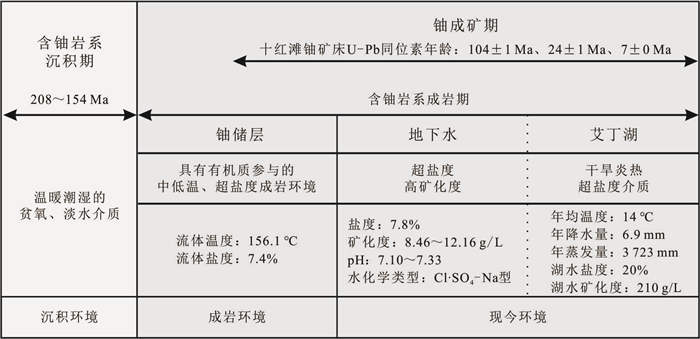
 下载:
下载:
